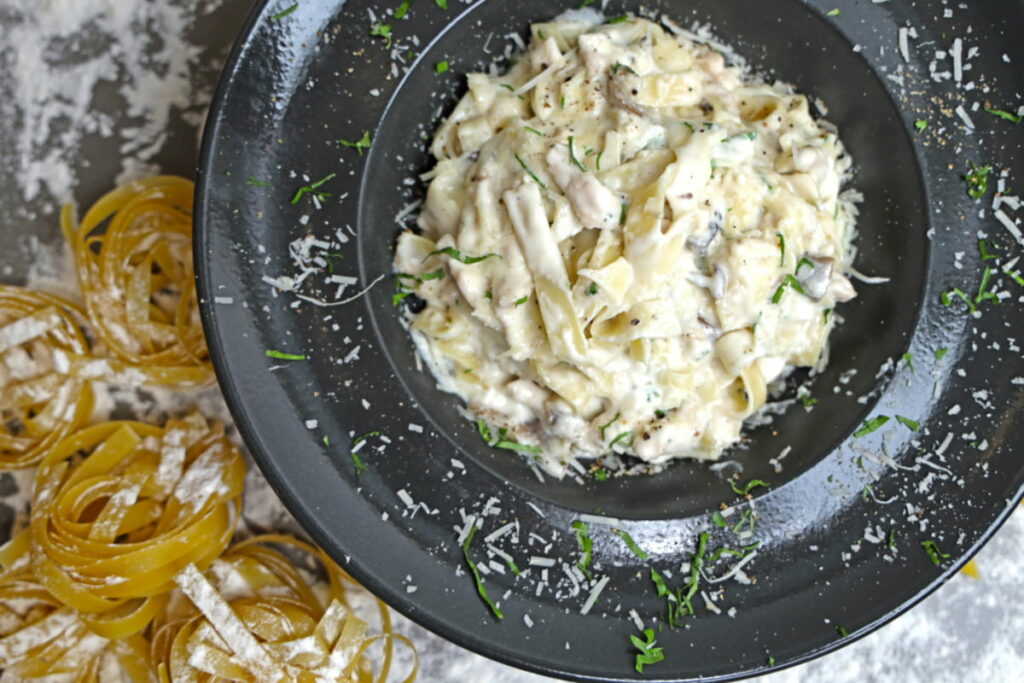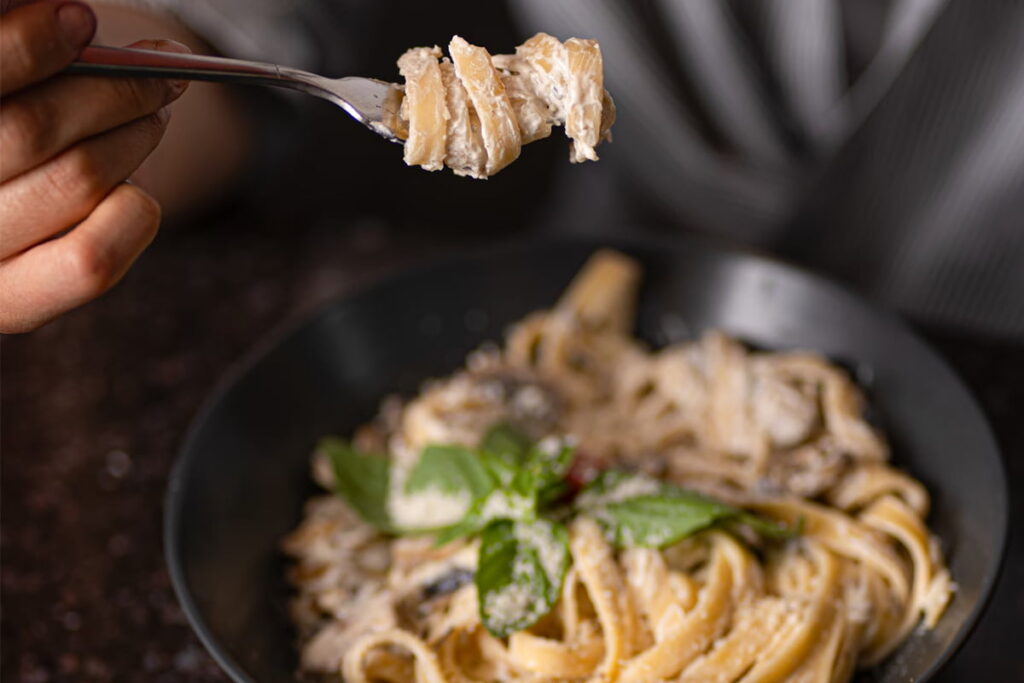
For years, I was one of those people, the ones who confidently say, “Oh yeah, you can freeze Alfredo sauce, just cool it first!”
Every food blog I’d ever read agreed. The instructions were practically copy-pasted:
Let the sauce cool, pour it into a container, label it, freeze it. Done.
So, naturally, I believed them.
One Sunday, after making a big batch of homemade Alfredo, I froze the leftovers. Future-me was going to eat like royalty.
Two weeks later, I thawed it, and instantly realized something was wrong.
The creamy, silky sauce I remembered had turned into an oily, grainy blob. The top was slick with butterfat; the bottom looked like curdled milk.
That’s when I called my uncle, who happens to be a chef, and blurted out:
“What on earth did I do wrong? Every blog said this was fine!”
He laughed (a little too hard), then gave me a mini masterclass on what actually happens when you freeze cream-based sauces.
What Really Happens When You Freeze Alfredo Sauce

Here’s what my uncle explained, in plain English:
Alfredo sauce is an emulsion, a delicate blend of fat (from butter and cream), water, and protein (from cheese).
When you freeze it, the cold breaks that emulsion. The fat and water separate, the proteins tighten, and when you reheat it, you get what looks like sauce that’s “broken”, oily on top, clumpy underneath.
It’s not that freezing Alfredo sauce is impossible.
It’s that freezing changes the structure, and few food blogs really explain why.
According to a food science review from the Institute of Food Technologists, sauces like Alfredo are oil-in-water emulsions, and those don’t handle freezing well. When the sauce freezes, ice crystals form and disrupt the smooth mix of fat and water.
Once thawed, the emulsion doesn’t snap back, leaving you with that greasy layer on top and clumps underneath, exactly what my uncle was describing.
And if you need proof this isn’t just lab theory, Reddit cooks in r/Culinary have reported the same thing: homemade Alfredo turning into buttery soup after freezing, unless they tweak it with stabilizers like sodium citrate or use commercial “culinary cream.”
As my uncle put it:
“Cream sauces are divas. You can freeze them, you just have to know how to talk them back into shape later.”
How to Freeze Alfredo Sauce (Safely)
After that whole experiment, and a crash course in sauce science from my uncle, I finally figured out the right way to freeze Alfredo sauce without ruining it.
Here’s what works for me:
- Let it cool completely. Warm sauce traps steam, which turns to ice crystals and wrecks the texture. Give it at least 30–45 minutes to fully cool before freezing.
- Freeze in small portions. Big containers take forever to thaw and tend to separate worse. Use silicone muffin cups, ice cube trays, or small airtight containers so you can grab what you need later.
- Seal it tight. Press out as much air as you can before freezing, air exposure is the fast track to freezer burn. A vacuum sealer or double-bag method works best.
- Label and freeze for up to 3 months. The sauce won’t go “bad” after that, but the texture decline becomes noticeable around the 8–10 week mark.
- Thaw it slowly. This is the real trick. Leave it in the fridge overnight; never on the counter or under hot water. Rapid thawing is what causes the separation you’ve seen online (and, well, in my kitchen).
What Most People Do (and Why It’s Only Half-Right)
If you look up how to freeze Alfredo sauce, you’ll find the same checklist everywhere:
- Let it cool completely.
- Pour into an airtight container.
- Label and freeze for up to 3 months.
That advice isn’t wrong, it’s just incomplete.
What I learned the hard way, and what matters more is how you thaw and rebuild the sauce afterward. You can’t just microwave it or heat it straight from frozen.
That’s how you end up with separated sauce.
How to Fix Split or Grainy Frozen Alfredo Sauce

This is the part my uncle “schooled” me on, and it completely changed how I handle creamy sauces.
When you thaw the sauce:
- Do it slowly. Leave it in the fridge overnight, never on the counter.
- Warm it gently. Use a low burner; never full blast.
- Whisk constantly. You’re re-emulsifying the fat and liquid, bringing them back together.
- Add a splash of cream or butter. That extra fat helps smooth everything out again.
Bonus tip from him:
“If it’s still looking rough, hit it with a hand whisk or a quick blend. You’re not rescuing it, you’re reminding it what it used to be.”
When Freezing Alfredo Sauce Is Worth It
Despite the drama, freezing Alfredo sauce can still be a win if you do it right.
- For meal prep: Freeze small portions (think ice cube trays or silicone cups) so you can thaw only what you need.
- For leftovers: Freeze the sauce separately from pasta, starch messes with the texture.
- For make-ahead dinners: Add the sauce to cooked chicken or broccoli after reheating, not before freezing.
If you want it as close to “fresh” as possible, my uncle recommends this pro move:
“Whisk in a touch of Parmesan or cream right after reheating. It restores the body and flavor you lost in the freeze.”
There You Go, It Can Be Done
Yes, you can freeze Alfredo sauce, but only if you treat it right. Cool it, portion it, seal it tight, and reheat it gently. Do that, and it’ll come back creamy instead of clumpy.
If you’re interested in how other foods freeze or want more real-world tips, check out the Freezing Hub.